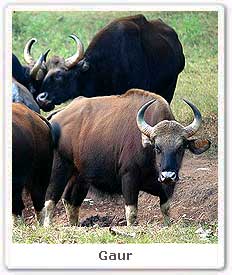| Kingdom : | Animalia |
| Phylum : | Chordata |
| Class: | Mammalia |
| Order : | Artiodactyla |
| Family : | Bovidae |
| Genus : | Bos |
| Species : | B.gaurus |
| Zoological name : | Bos gaurus |
| Found In | Bandipur National Park, Kaziranga Natioanl Park and Manas National Park in India |
 Physical appearance : Gaurs are 8.3 to 12 feet long.
Males weigh around 1000- 1500 kg and the females weigh around 700 –
1000 kg. Males Gaurs are larger than the female Gaurs. Males are dark brown
while the females are rust coloured. They have white colour legs. Length of
their tail exceeds to 70- 100 cm.
Physical appearance : Gaurs are 8.3 to 12 feet long.
Males weigh around 1000- 1500 kg and the females weigh around 700 –
1000 kg. Males Gaurs are larger than the female Gaurs. Males are dark brown
while the females are rust coloured. They have white colour legs. Length of
their tail exceeds to 70- 100 cm. Presence in India : Gaurs are found in the forested areas of Karnataka, Assam and other parts of India . They are also spotted a Bandipur,Kaziranga and Manas National park in India.
Habitat : Gaur prefers to live in the mountainous regions in evergreen, deciduous and savanna forests.
Diet : Gaurs are herbivorous. They feed on grass, leaves, plants, creepers, herbs, bamboo.
Reproduction : Gaur reach the sexual maturity in 2- 3 years. Gestation period rests for 275 days. Females give birth to one calf. Gaurs breed during the summer season. Females reach the sexual maturity in 3 years, while the males take longer time to reach sexual maturity.
Conservation status : The gaur is classified as vulnerable (Criteria: A1cd+2cd, C1+2a) by the IUCN (2002), and is on Appendix I of CITES [excluding the domestic B. f. frontalis] (2003).
Lifespan : Lifespan of the Gaur is upto 30 years.






